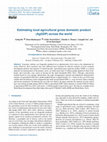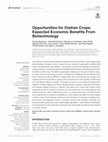Papers by Ulrike Wood-Sichra

Earth System Science Data
Economic statistics are frequently produced at an administrative level such as the subnational di... more Economic statistics are frequently produced at an administrative level such as the subnational division. However, these measures may lack sufficient local variation for effective analysis of local economic development patterns and exposure to natural hazards. Agricultural gross domestic product (GDP) is a critical indicator for measurement of the primary sector, on which more than 2.5 billion people depend for their livelihoods, and it provides a key source of income for the entire household (FAO, 2021). Through a data-fusion method based on cross-entropy optimization, this paper disaggregates national and subnational administrative statistics of agricultural GDP into a global gridded dataset at approximately 10 × 10 km for the year 2010 using satellite-derived indicators of the components that make up agricultural GDP, i.e., crop, livestock, fishery, hunting and forestry production. To illustrate the use of the new dataset, the paper estimates the exposure of areas with at least one extreme drought during 2000 to 2009 to agricultural GDP, which amounts to around USD 432 billion of agricultural GDP circa 2010, with nearly 1.2 billion people living in those areas. The data are available on the World Bank Development Data Hub (https://doi.org/10.57966/0j71-8d56; IFPRI and World Bank, 2022).
SPAM2017V1R1_SSA_HARV_AREA.GEOTIFF.ZIP
SPAM2017V1R1_SSA_ADMINLEVEL1.CSV.ZIP
The acceptance of the X.25 international standards requires a virtual call procedure, which impos... more The acceptance of the X.25 international standards requires a virtual call procedure, which imposes some restriction on the usage of communication resources, namely a fixed route for the whole duration of the session. In an example of network simulation, datagram and virtual call methods are compared, producing the result that the datagram gives a better performance with regard to delivery time. The difference between these two methods is greater when the load, the number of packets per message, and the size of the network is increased.

Frontiers in Plant Science
An enabling, evidence-based decision-making framework is critical to support agricultural biotech... more An enabling, evidence-based decision-making framework is critical to support agricultural biotechnology innovation, and to ensure farmers’ access to genetically modified (GM) crops, including orphan crop varieties. A key element, and often a challenge in the decision-making process, involves the balancing of identified potential risks with expected economic benefits from GM crops. The latter is particularly challenging in the case of orphan crops, for which solid economic data is scarce. To address this challenge, the International Food Policy Research Institute (IFPRI) in collaboration with local economists analyzed the expected economic benefits to farmers and consumers from the adoption of GM crops in 5 sub-Saharan African countries. This paper focuses on case studies involving insect-resistant cowpea in Nigeria and Ghana; disease-resistant cassava in Uganda and Tanzania; and disease-resistant banana in Uganda. Estimations from these case studies show substantial economic benefit...
SPAM2017V1R1_SSA_YIELD_QUANT.GEOTIFF.ZIP
SPAM2010V2R0_GLOBAL_HARV_AREA.DBF.ZIP
SPAM2010V2R0_GLOBAL_PHYS_AREA.GEOTIFF.ZIP
SPAM2010V2R0_GLOBAL_PROD.GEOTIFF.ZIP
SPAM2010V2R0_GLOBAL_PROD.DBF.ZIP
SPAM2010V2R0_GLOBAL_YIELD.DBF.ZIP
The Policy Research Working Paper Series disseminates the findings of work in progress to encoura... more The Policy Research Working Paper Series disseminates the findings of work in progress to encourage the exchange of ideas about development issues. An objective of the series is to get the findings out quickly, even if the presentations are less than fully polished. The papers carry the names of the authors and should be cited accordingly. The findings, interpretations, and conclusions expressed in this paper are entirely those of the authors. They do not necessarily represent the views of the International Bank for Reconstruction and Development/World Bank and its affiliated organizations, or those of the Executive Directors of the World Bank or the governments they represent.
Virtual Circuits Versus Datagram - Usage of Communication Resources

PLOS ONE, 2019
Worldwide, crop production is intrinsically intertwined with biological, environmental and econom... more Worldwide, crop production is intrinsically intertwined with biological, environmental and economic systems, all of which involve complex, interrelated and spatially-sensitive phenomena. Thus knowing the location of agriculture matters much for a host of reasons. There are several widely cited attempts to model the spatial pattern of crop production worldwide, not least by pixilating crop production statistics originally reported on an areal (administrative boundary) basis. However, these modeled measures have had little scrutiny regarding the robustness of their results to alternative data and modeling choices. Our research casts a critical eye over the nature and empirical plausibility of these types of datasets. To do so, we determine the sensitivity of the 2005 variant of the spatial production allocation model data series (SPAM2005) to eight methodological-cum-data choices in nine agriculturally-large and developmentally-variable countries:

Research Report 150, 2006
and Uganda-where tens of millions of people face ongoing poverty, hunger, and malnutrition. This ... more and Uganda-where tens of millions of people face ongoing poverty, hunger, and malnutrition. This report, the result of a two-year collaboration between the International Food Policy Research Institute and the Association for Strengthening Agricultural Research in Eastern and Central Africa, identifies how eastern and central African countries can stimulate agricultural growth to address these dire circumstances. The findings suggest that improved agricultural performance will require investments that foster productivity growth, strengthen markets, improve rural linkages between the agricultural and nonagricultural sectors, and promote regional cooperation. Of particular interest is the identification of the most performance-enhancing commodity subsectors, in an economywide setting, and the "agricultural development domain" singled out as most promising for targeted investment. These results and their implications are being widely discussed and debated in the countries of eastern and central Africa, in many cases shaping policy and investment strategies. We hope that the findings, made available through this report, will elicit similar responses in other regions.

F1000Research, 2016
Recent progress in large-scale georeferenced data collection is widening opportunities for combin... more Recent progress in large-scale georeferenced data collection is widening opportunities for combining multi-disciplinary datasets from biophysical to socioeconomic domains, advancing our analytical and modeling capacity. Granular spatial datasets provide critical information necessary for decision makers to identify target areas, assess baseline conditions, prioritize investment options, set goals and targets and monitor impacts. However, key challenges in reconciling data across themes, scales and borders restrict our capacity to produce global and regional maps and time series. This paper provides overview, structure and coverage of CELL5M—an open-access database of geospatial indicators at 5 arc-minute grid resolution—and introduces a range of analytical applications and case-uses. CELL5M covers a wide set of agriculture-relevant domains for all countries in Africa South of the Sahara and supports our understanding of multi-dimensional spatial variability inherent in farming lands...
Virtual Circuits Versus Datagram - Usage of Communication Resources
Proceedings of the Third International Symposium on Modelling and Performance Evaluation of Computer Systems Performance of Computer Systems, Feb 6, 1979

Frontiers in Plant Science
An enabling, evidence-based decision-making framework is critical to support agricultural biotech... more An enabling, evidence-based decision-making framework is critical to support agricultural biotechnology innovation, and to ensure farmers’ access to genetically modified (GM) crops, including orphan crop varieties. A key element, and often a challenge in the decision-making process, involves the balancing of identified potential risks with expected economic benefits from GM crops. The latter is particularly challenging in the case of orphan crops, for which solid economic data is scarce. To address this challenge, the International Food Policy Research Institute (IFPRI) in collaboration with local economists analyzed the expected economic benefits to farmers and consumers from the adoption of GM crops in 5 sub-Saharan African countries. This paper focuses on case studies involving insect-resistant cowpea in Nigeria and Ghana; disease-resistant cassava in Uganda and Tanzania; and disease-resistant banana in Uganda. Estimations from these case studies show substantial economic benefit...
Uploads
Papers by Ulrike Wood-Sichra